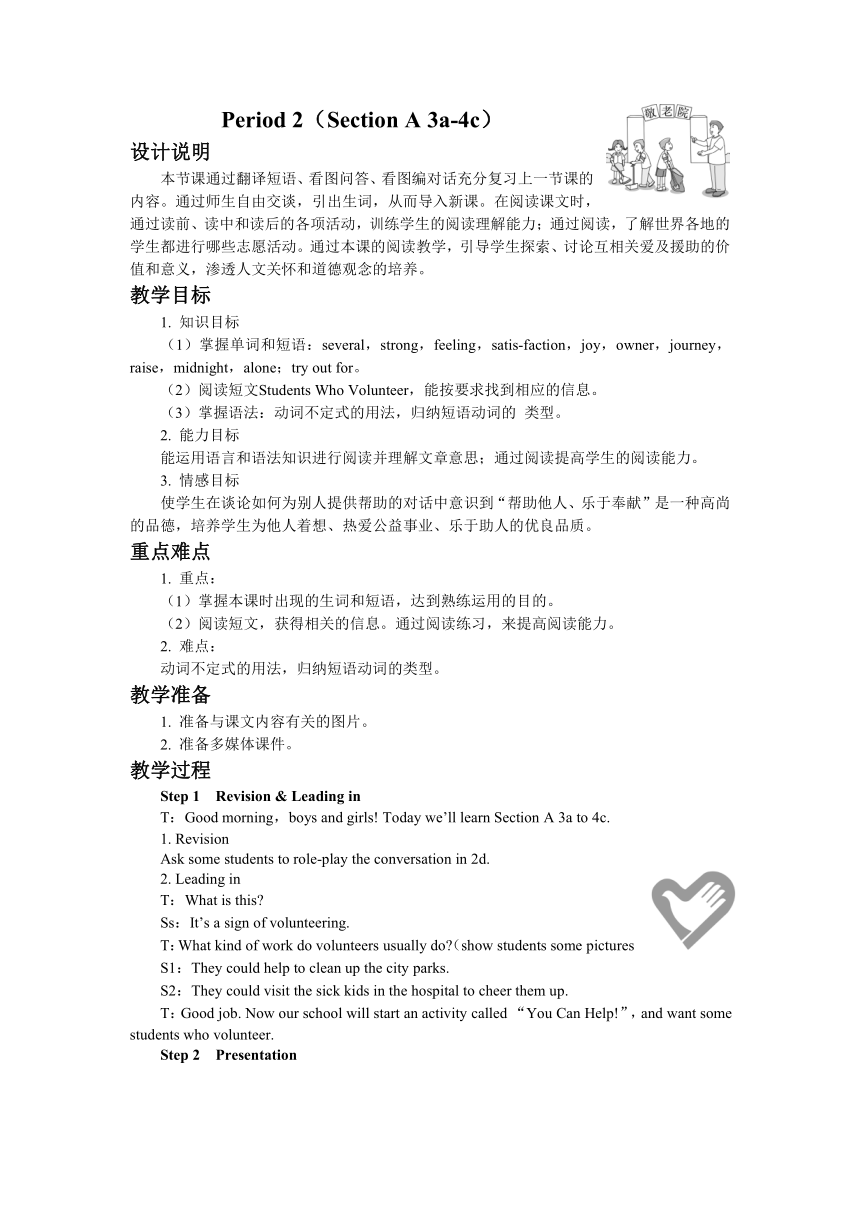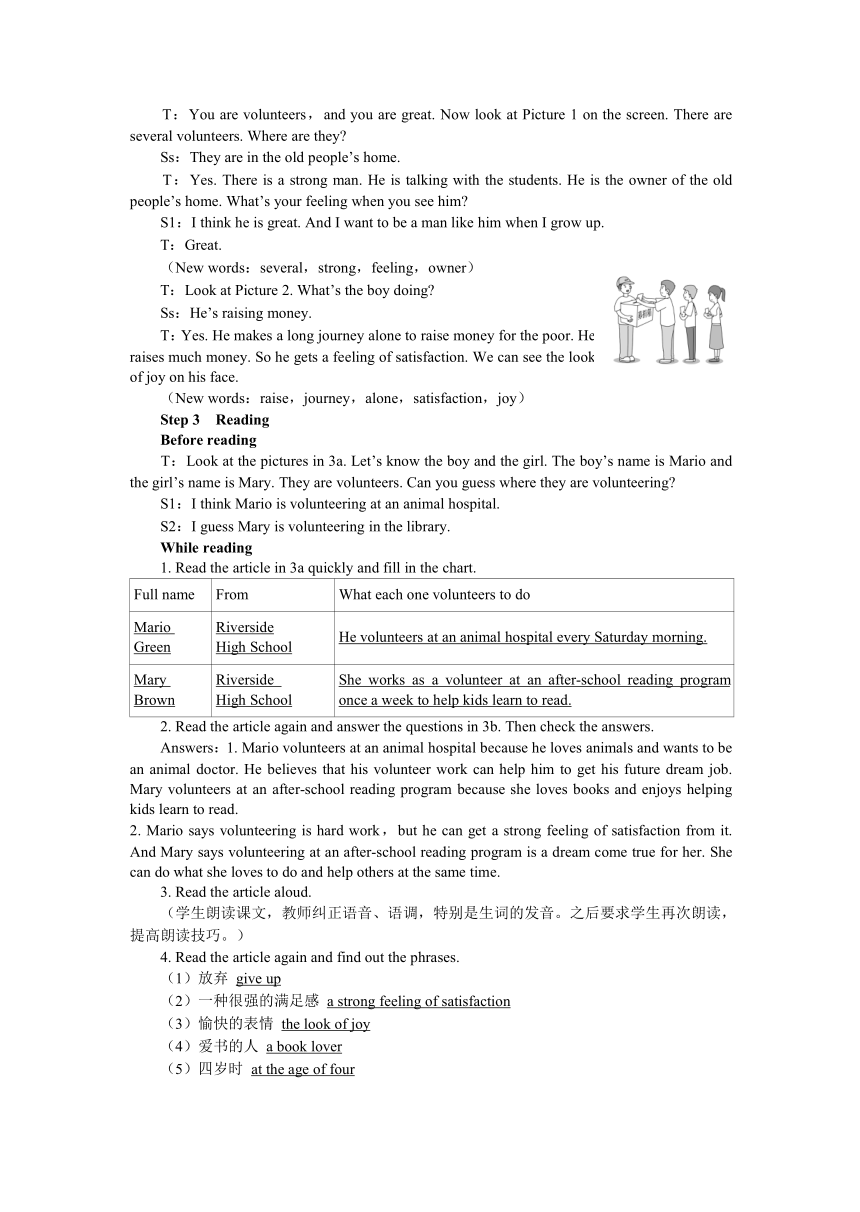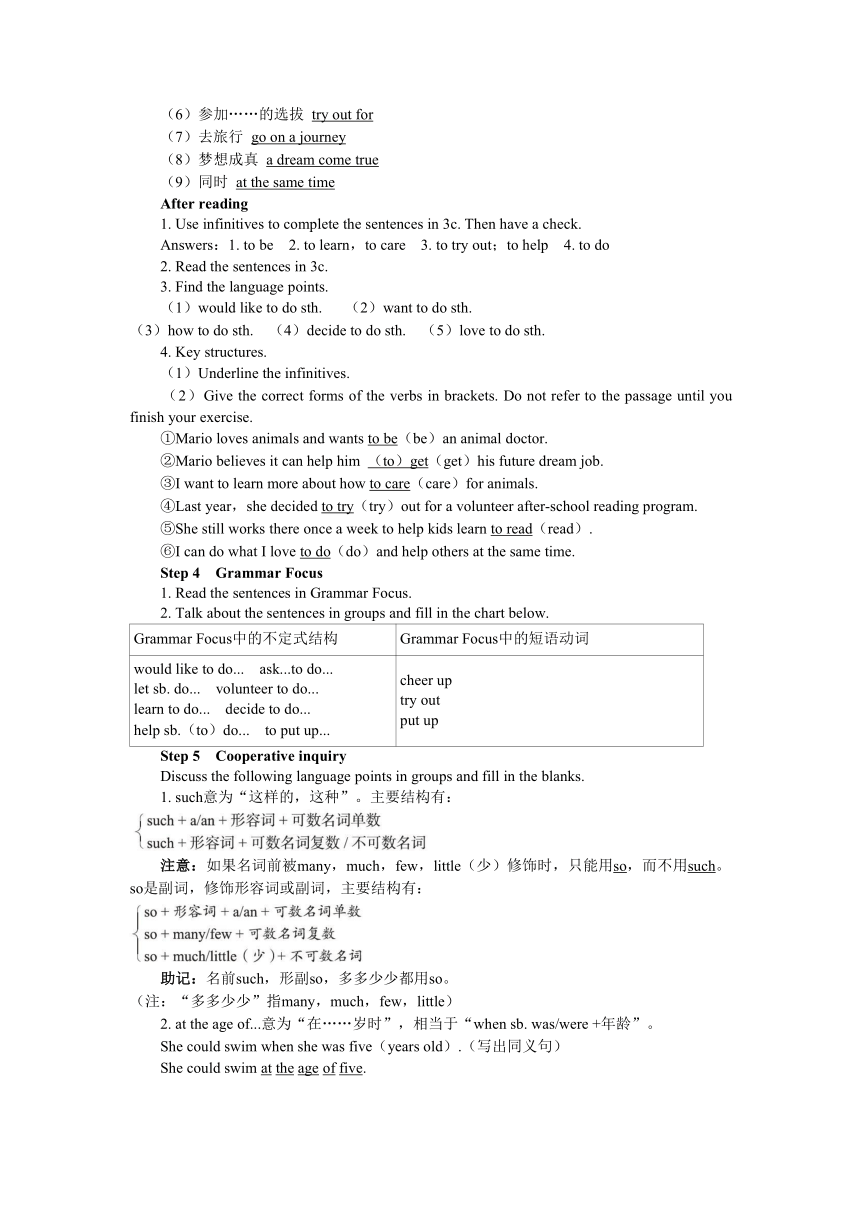UNIT 2 Period 2 (Section A 3a-4c)教学详案
文档属性
| 名称 | UNIT 2 Period 2 (Section A 3a-4c)教学详案 |  | |
| 格式 | docx | ||
| 文件大小 | 1.0MB | ||
| 资源类型 | 试卷 | ||
| 版本资源 | 人教新目标(Go for it)版 | ||
| 科目 | 英语 | ||
| 更新时间 | 2024-02-21 19:33:35 | ||
图片预览



文档简介
Period 2(Section A 3a-4c)
设计说明
本节课通过翻译短语、看图问答、看图编对话充分复习上一节课的内容。通过师生自由交谈,引出生词,从而导入新课。在阅读课文时,通过读前、读中和读后的各项活动,训练学生的阅读理解能力;通过阅读,了解世界各地的学生都进行哪些志愿活动。通过本课的阅读教学,引导学生探索、讨论互相关爱及援助的价值和意义,渗透人文关怀和道德观念的培养。
教学目标
1. 知识目标
(1)掌握单词和短语:several,strong,feeling,satis-faction,joy,owner,journey,raise,midnight,alone;try out for。
(2)阅读短文Students Who Volunteer,能按要求找到相应的信息。
(3)掌握语法:动词不定式的用法,归纳短语动词的 类型。
2. 能力目标
能运用语言和语法知识进行阅读并理解文章意思;通过阅读提高学生的阅读能力。
3. 情感目标
使学生在谈论如何为别人提供帮助的对话中意识到“帮助他人、乐于奉献”是一种高尚的品德,培养学生为他人着想、热爱公益事业、乐于助人的优良品质。
重点难点
1. 重点:
(1)掌握本课时出现的生词和短语,达到熟练运用的目的。
(2)阅读短文,获得相关的信息。通过阅读练习,来提高阅读能力。
2. 难点:
动词不定式的用法,归纳短语动词的类型。
教学准备
1. 准备与课文内容有关的图片。
2. 准备多媒体课件。
教学过程
Step 1 Revision & Leading in
T:Good morning,boys and girls! Today we’ll learn Section A 3a to 4c.
1. Revision
Ask some students to role-play the conversation in 2d.
2. Leading in
T:What is this
Ss:It’s a sign of volunteering.
T:What kind of work do volunteers usually do (show students some pictures)
S1:They could help to clean up the city parks.
S2:They could visit the sick kids in the hospital to cheer them up.
T:Good job. Now our school will start an activity called “You Can Help!”,and want some students who volunteer.
Step 2 Presentation
T:You are volunteers,and you are great. Now look at Picture 1 on the screen. There are several volunteers. Where are they
Ss:They are in the old people’s home.
T:Yes. There is a strong man. He is talking with the students. He is the owner of the old people’s home. What’s your feeling when you see him
S1:I think he is great. And I want to be a man like him when I grow up.
T:Great.
(New words:several,strong,feeling,owner)
T:Look at Picture 2. What’s the boy doing
Ss:He’s raising money.
T:Yes. He makes a long journey alone to raise money for the poor. He raises much money. So he gets a feeling of satisfaction. We can see the look of joy on his face.
(New words:raise,journey,alone,satisfaction,joy)
Step 3 Reading
Before reading
T:Look at the pictures in 3a. Let’s know the boy and the girl. The boy’s name is Mario and the girl’s name is Mary. They are volunteers. Can you guess where they are volunteering
S1:I think Mario is volunteering at an animal hospital.
S2:I guess Mary is volunteering in the library.
While reading
1. Read the article in 3a quickly and fill in the chart.
Full name From What each one volunteers to do
Mario Green Riverside High School He volunteers at an animal hospital every Saturday morning.
Mary Brown Riverside High School She works as a volunteer at an after-school reading program once a week to help kids learn to read.
2. Read the article again and answer the questions in 3b. Then check the answers.
Answers:1. Mario volunteers at an animal hospital because he loves animals and wants to be an animal doctor. He believes that his volunteer work can help him to get his future dream job. Mary volunteers at an after-school reading program because she loves books and enjoys helping kids learn to read.
2. Mario says volunteering is hard work,but he can get a strong feeling of satisfaction from it. And Mary says volunteering at an after-school reading program is a dream come true for her. She can do what she loves to do and help others at the same time.
3. Read the article aloud.
(学生朗读课文,教师纠正语音、语调,特别是生词的发音。之后要求学生再次朗读,提高朗读技巧。)
4. Read the article again and find out the phrases.
(1)放弃 give up
(2)一种很强的满足感 a strong feeling of satisfaction
(3)愉快的表情 the look of joy
(4)爱书的人 a book lover
(5)四岁时 at the age of four
(6)参加……的选拔 try out for
(7)去旅行 go on a journey
(8)梦想成真 a dream come true
(9)同时 at the same time
After reading
1. Use infinitives to complete the sentences in 3c. Then have a check.
Answers:1. to be 2. to learn,to care 3. to try out;to help 4. to do
2. Read the sentences in 3c.
3. Find the language points.
(1)would like to do sth. (2)want to do sth.
(3)how to do sth. (4)decide to do sth. (5)love to do sth.
4. Key structures.
(1)Underline the infinitives.
(2)Give the correct forms of the verbs in brackets. Do not refer to the passage until you finish your exercise.
①Mario loves animals and wants to be(be)an animal doctor.
②Mario believes it can help him (to)get(get)his future dream job.
③I want to learn more about how to care(care)for animals.
④Last year,she decided to try(try)out for a volunteer after-school reading program.
⑤She still works there once a week to help kids learn to read(read).
⑥I can do what I love to do(do)and help others at the same time.
Step 4 Grammar Focus
1. Read the sentences in Grammar Focus.
2. Talk about the sentences in groups and fill in the chart below.
Grammar Focus中的不定式结构 Grammar Focus中的短语动词
would like to do... ask...to do... let sb. do... volunteer to do... learn to do... decide to do... help sb.(to)do... to put up... cheer up try out put up
Step 5 Cooperative inquiry
Discuss the following language points in groups and fill in the blanks.
1. such意为“这样的,这种”。主要结构有:
注意:如果名词前被many,much,few,little(少)修饰时,只能用so,而不用such。so是副词,修饰形容词或副词,主要结构有:
助记:名前such,形副so,多多少少都用so。
(注:“多多少少”指many,much,few,little)
2. at the age of...意为“在……岁时”,相当于“when sb. was/were +年龄”。
She could swim when she was five(years old).(写出同义句)
She could swim at the age of five.
3. try out,try out for
(1)try out意为“试用;试验”。
I’m trying out a new computer. 我在试用一台新电脑。
(2)try out for意为“参加……选拔”。
He tried out for(参加……选拔)the school play yesterday.
4. 动词不定式的用法归纳:
a. 构成:to +动词原形 否定式:not to +动词原形
b. 用法:动词不定式是一种非谓语动词形式,在句中可以充当宾语、宾语补足语、状语、主语以及定语等。
(1)作动词宾语,常见动词有want,help,learn,try,remember,hope,decide,volunteer等。
We hope to leave(leave)at once.
He’ll try not to be(not be)late again.
(2)作宾语补足语,常见动词有ask,tell,want,order等。
The doctor told him to drink(drink)more water.
(3)作状语,表示目的、原因、结果等。
We are working hard to live(live)a better life.
(4)作主语。为避免句子头重脚轻,常用it作形式主语,而真正的主语是后面的动词不定式。
常用句型:It + be + adj. +(for/of sb.)to do sth.
(5)作定语。
Jack missed a great chance to make(make)a lot of money.
注意:(1)动词help后既可跟带to的动词不定式,也可跟省略to的动词不定式。
(2)在使役动词make,have,let和感官动词see,watch,hear等后接不带to的动词不定式作宾语补足语。
Step 6 Practice
1. Read the phrasal verbs in the box in 4a and put them into Chinese.
2. Fill in the blanks with the phrasal verbs in the box in 4a. Then check the answers.
Answers:1. put off 2. call up 3. come up with,cheer up 4. put up,hand out;give out
3. Fill in the blanks in 4b. First do it by yourself,and then check the answers in groups.
Answers:to make;to do;to help;to spend;to visit;to move
4. Read the passage in 4b.
5. Complete the sentences with your own ideas in 4c. Use infinitives. Talk about them in groups.
Step 7 Make a survey
假设你们班打算去敬老院做志愿活动,下面表格是你们班一些同学的爱好,请根据表格内容安排他们能做的事情。
Name Interests What could they do
Alice singing
Amy talking with people
Peter working outside
Tom drawing
Fill in the chart and report it like this:Alice is interested in singing. She could sing some old songs for the old people...
Step 8 Summary
In this lesson we have learned an article titled Students Who Volunteer. In the article,we learn some new words and some phrases:several,strong,feeling,satisfaction,joy,owner,journey,raise,midnight,alone;try out...At last we sum up the infinitives and phrasal verbs.
当堂达标(见导学案“当堂达标”)
答案与解析:
Ⅰ. 1. satisfaction 2. several 3. joy 4. owner
5. feeling 6. journey
Ⅱ. 1. to help would like to do sth. 意为“愿意做某事”。
2. to go 句意为“他想知道什么时候去”。when to go是“疑问词+动词不定式”结构。
3. to ask,to help need to do sth. 意为“需要做某事”;ask sb. to do sth. 意为“要求某人做某事”。
4. to travel decide to do sth. 意为“决定做某事”。
5. making put off doing sth. 意为“推迟做某事”。
6. not to read tell sb. not to do sth. 意为“告诉某人不要做某事”。
7. smoking give up doing sth. 意为“放弃做某事”。
Ⅲ. 1. at the age of 2. to try out 3. come true
4. is busy with 5. worried about 6. so many flowers
Ⅳ. 1. B 由下文中“然而……我认为它很好”可知,此处应选表示否定意义的词;meaningless(毫无意义的)表示否定意义。故选B。句意为“很多人认为志愿者工作没有意义”。
2. A 由上文“你们想成为志愿者吗?”可知,此处表示 “当我成了一个志愿者时”,故选volunteer(志愿者)。
3. B 由下文中their kids可推知此处表示“有很多父母加入”,故选parents(父母)。
4. D spend time with sb.意为“与某人一起度过时光”,为固定短语,故选D。
5. C 由下文中in all kinds of activities(在所有种类的活动中)可知,句意为“从他们到达的时候,你可以到处看到这些父母”。故选everywhere(每个地方,到处)。
6. B 由句中的helped a lot 可推知此处应说明帮助的方式;by doing sth. 意为“通过做某事的方式”,故 选B。
7. D take part in意为“参加,参与”,为固定短语,故选D。
8. C 由句中“他们充满了精力”可知,此处表示“能够做如此多的工作”,be able to do sth.意为“能够做某事”,故选C。
9. A difficult形容词,意为“困难的”;different形容词,意为“不同的”;difference名词,意为“差异”;difficulty名词,意为“困难”。由第一段中“我认为它很好”可知此处表示“彼此说再见很难”,排除B,C;由句子结构可知,此处应用形容词作表语,故选A。
10. C fix up意为“修理”;give up意为“放弃”;ask for意为“请求,要求”;set up意为“建立”。由句意 “他们总是给予,但从不 任何回报”可知,此处C项符合题意,故选C。
Step 9 Homework
1. Make sentences with the phrases below. Put up,hand out,call up,cheer up,come up with,give out,put off.
2. Retell 3a.
板书设计
UNIT 2 I’ll help to clean up the city parks. Period 2(Section A 3a-4c)
several strong feeling satisfaction joy owner journey midnight alone give up try out for... go on a journey at the same time at the age of raise money for
教学反思
设计说明
本节课通过翻译短语、看图问答、看图编对话充分复习上一节课的内容。通过师生自由交谈,引出生词,从而导入新课。在阅读课文时,通过读前、读中和读后的各项活动,训练学生的阅读理解能力;通过阅读,了解世界各地的学生都进行哪些志愿活动。通过本课的阅读教学,引导学生探索、讨论互相关爱及援助的价值和意义,渗透人文关怀和道德观念的培养。
教学目标
1. 知识目标
(1)掌握单词和短语:several,strong,feeling,satis-faction,joy,owner,journey,raise,midnight,alone;try out for。
(2)阅读短文Students Who Volunteer,能按要求找到相应的信息。
(3)掌握语法:动词不定式的用法,归纳短语动词的 类型。
2. 能力目标
能运用语言和语法知识进行阅读并理解文章意思;通过阅读提高学生的阅读能力。
3. 情感目标
使学生在谈论如何为别人提供帮助的对话中意识到“帮助他人、乐于奉献”是一种高尚的品德,培养学生为他人着想、热爱公益事业、乐于助人的优良品质。
重点难点
1. 重点:
(1)掌握本课时出现的生词和短语,达到熟练运用的目的。
(2)阅读短文,获得相关的信息。通过阅读练习,来提高阅读能力。
2. 难点:
动词不定式的用法,归纳短语动词的类型。
教学准备
1. 准备与课文内容有关的图片。
2. 准备多媒体课件。
教学过程
Step 1 Revision & Leading in
T:Good morning,boys and girls! Today we’ll learn Section A 3a to 4c.
1. Revision
Ask some students to role-play the conversation in 2d.
2. Leading in
T:What is this
Ss:It’s a sign of volunteering.
T:What kind of work do volunteers usually do (show students some pictures)
S1:They could help to clean up the city parks.
S2:They could visit the sick kids in the hospital to cheer them up.
T:Good job. Now our school will start an activity called “You Can Help!”,and want some students who volunteer.
Step 2 Presentation
T:You are volunteers,and you are great. Now look at Picture 1 on the screen. There are several volunteers. Where are they
Ss:They are in the old people’s home.
T:Yes. There is a strong man. He is talking with the students. He is the owner of the old people’s home. What’s your feeling when you see him
S1:I think he is great. And I want to be a man like him when I grow up.
T:Great.
(New words:several,strong,feeling,owner)
T:Look at Picture 2. What’s the boy doing
Ss:He’s raising money.
T:Yes. He makes a long journey alone to raise money for the poor. He raises much money. So he gets a feeling of satisfaction. We can see the look of joy on his face.
(New words:raise,journey,alone,satisfaction,joy)
Step 3 Reading
Before reading
T:Look at the pictures in 3a. Let’s know the boy and the girl. The boy’s name is Mario and the girl’s name is Mary. They are volunteers. Can you guess where they are volunteering
S1:I think Mario is volunteering at an animal hospital.
S2:I guess Mary is volunteering in the library.
While reading
1. Read the article in 3a quickly and fill in the chart.
Full name From What each one volunteers to do
Mario Green Riverside High School He volunteers at an animal hospital every Saturday morning.
Mary Brown Riverside High School She works as a volunteer at an after-school reading program once a week to help kids learn to read.
2. Read the article again and answer the questions in 3b. Then check the answers.
Answers:1. Mario volunteers at an animal hospital because he loves animals and wants to be an animal doctor. He believes that his volunteer work can help him to get his future dream job. Mary volunteers at an after-school reading program because she loves books and enjoys helping kids learn to read.
2. Mario says volunteering is hard work,but he can get a strong feeling of satisfaction from it. And Mary says volunteering at an after-school reading program is a dream come true for her. She can do what she loves to do and help others at the same time.
3. Read the article aloud.
(学生朗读课文,教师纠正语音、语调,特别是生词的发音。之后要求学生再次朗读,提高朗读技巧。)
4. Read the article again and find out the phrases.
(1)放弃 give up
(2)一种很强的满足感 a strong feeling of satisfaction
(3)愉快的表情 the look of joy
(4)爱书的人 a book lover
(5)四岁时 at the age of four
(6)参加……的选拔 try out for
(7)去旅行 go on a journey
(8)梦想成真 a dream come true
(9)同时 at the same time
After reading
1. Use infinitives to complete the sentences in 3c. Then have a check.
Answers:1. to be 2. to learn,to care 3. to try out;to help 4. to do
2. Read the sentences in 3c.
3. Find the language points.
(1)would like to do sth. (2)want to do sth.
(3)how to do sth. (4)decide to do sth. (5)love to do sth.
4. Key structures.
(1)Underline the infinitives.
(2)Give the correct forms of the verbs in brackets. Do not refer to the passage until you finish your exercise.
①Mario loves animals and wants to be(be)an animal doctor.
②Mario believes it can help him (to)get(get)his future dream job.
③I want to learn more about how to care(care)for animals.
④Last year,she decided to try(try)out for a volunteer after-school reading program.
⑤She still works there once a week to help kids learn to read(read).
⑥I can do what I love to do(do)and help others at the same time.
Step 4 Grammar Focus
1. Read the sentences in Grammar Focus.
2. Talk about the sentences in groups and fill in the chart below.
Grammar Focus中的不定式结构 Grammar Focus中的短语动词
would like to do... ask...to do... let sb. do... volunteer to do... learn to do... decide to do... help sb.(to)do... to put up... cheer up try out put up
Step 5 Cooperative inquiry
Discuss the following language points in groups and fill in the blanks.
1. such意为“这样的,这种”。主要结构有:
注意:如果名词前被many,much,few,little(少)修饰时,只能用so,而不用such。so是副词,修饰形容词或副词,主要结构有:
助记:名前such,形副so,多多少少都用so。
(注:“多多少少”指many,much,few,little)
2. at the age of...意为“在……岁时”,相当于“when sb. was/were +年龄”。
She could swim when she was five(years old).(写出同义句)
She could swim at the age of five.
3. try out,try out for
(1)try out意为“试用;试验”。
I’m trying out a new computer. 我在试用一台新电脑。
(2)try out for意为“参加……选拔”。
He tried out for(参加……选拔)the school play yesterday.
4. 动词不定式的用法归纳:
a. 构成:to +动词原形 否定式:not to +动词原形
b. 用法:动词不定式是一种非谓语动词形式,在句中可以充当宾语、宾语补足语、状语、主语以及定语等。
(1)作动词宾语,常见动词有want,help,learn,try,remember,hope,decide,volunteer等。
We hope to leave(leave)at once.
He’ll try not to be(not be)late again.
(2)作宾语补足语,常见动词有ask,tell,want,order等。
The doctor told him to drink(drink)more water.
(3)作状语,表示目的、原因、结果等。
We are working hard to live(live)a better life.
(4)作主语。为避免句子头重脚轻,常用it作形式主语,而真正的主语是后面的动词不定式。
常用句型:It + be + adj. +(for/of sb.)to do sth.
(5)作定语。
Jack missed a great chance to make(make)a lot of money.
注意:(1)动词help后既可跟带to的动词不定式,也可跟省略to的动词不定式。
(2)在使役动词make,have,let和感官动词see,watch,hear等后接不带to的动词不定式作宾语补足语。
Step 6 Practice
1. Read the phrasal verbs in the box in 4a and put them into Chinese.
2. Fill in the blanks with the phrasal verbs in the box in 4a. Then check the answers.
Answers:1. put off 2. call up 3. come up with,cheer up 4. put up,hand out;give out
3. Fill in the blanks in 4b. First do it by yourself,and then check the answers in groups.
Answers:to make;to do;to help;to spend;to visit;to move
4. Read the passage in 4b.
5. Complete the sentences with your own ideas in 4c. Use infinitives. Talk about them in groups.
Step 7 Make a survey
假设你们班打算去敬老院做志愿活动,下面表格是你们班一些同学的爱好,请根据表格内容安排他们能做的事情。
Name Interests What could they do
Alice singing
Amy talking with people
Peter working outside
Tom drawing
Fill in the chart and report it like this:Alice is interested in singing. She could sing some old songs for the old people...
Step 8 Summary
In this lesson we have learned an article titled Students Who Volunteer. In the article,we learn some new words and some phrases:several,strong,feeling,satisfaction,joy,owner,journey,raise,midnight,alone;try out...At last we sum up the infinitives and phrasal verbs.
当堂达标(见导学案“当堂达标”)
答案与解析:
Ⅰ. 1. satisfaction 2. several 3. joy 4. owner
5. feeling 6. journey
Ⅱ. 1. to help would like to do sth. 意为“愿意做某事”。
2. to go 句意为“他想知道什么时候去”。when to go是“疑问词+动词不定式”结构。
3. to ask,to help need to do sth. 意为“需要做某事”;ask sb. to do sth. 意为“要求某人做某事”。
4. to travel decide to do sth. 意为“决定做某事”。
5. making put off doing sth. 意为“推迟做某事”。
6. not to read tell sb. not to do sth. 意为“告诉某人不要做某事”。
7. smoking give up doing sth. 意为“放弃做某事”。
Ⅲ. 1. at the age of 2. to try out 3. come true
4. is busy with 5. worried about 6. so many flowers
Ⅳ. 1. B 由下文中“然而……我认为它很好”可知,此处应选表示否定意义的词;meaningless(毫无意义的)表示否定意义。故选B。句意为“很多人认为志愿者工作没有意义”。
2. A 由上文“你们想成为志愿者吗?”可知,此处表示 “当我成了一个志愿者时”,故选volunteer(志愿者)。
3. B 由下文中their kids可推知此处表示“有很多父母加入”,故选parents(父母)。
4. D spend time with sb.意为“与某人一起度过时光”,为固定短语,故选D。
5. C 由下文中in all kinds of activities(在所有种类的活动中)可知,句意为“从他们到达的时候,你可以到处看到这些父母”。故选everywhere(每个地方,到处)。
6. B 由句中的helped a lot 可推知此处应说明帮助的方式;by doing sth. 意为“通过做某事的方式”,故 选B。
7. D take part in意为“参加,参与”,为固定短语,故选D。
8. C 由句中“他们充满了精力”可知,此处表示“能够做如此多的工作”,be able to do sth.意为“能够做某事”,故选C。
9. A difficult形容词,意为“困难的”;different形容词,意为“不同的”;difference名词,意为“差异”;difficulty名词,意为“困难”。由第一段中“我认为它很好”可知此处表示“彼此说再见很难”,排除B,C;由句子结构可知,此处应用形容词作表语,故选A。
10. C fix up意为“修理”;give up意为“放弃”;ask for意为“请求,要求”;set up意为“建立”。由句意 “他们总是给予,但从不 任何回报”可知,此处C项符合题意,故选C。
Step 9 Homework
1. Make sentences with the phrases below. Put up,hand out,call up,cheer up,come up with,give out,put off.
2. Retell 3a.
板书设计
UNIT 2 I’ll help to clean up the city parks. Period 2(Section A 3a-4c)
several strong feeling satisfaction joy owner journey midnight alone give up try out for... go on a journey at the same time at the age of raise money for
教学反思
同课章节目录
- Unit 1 What's the matter?
- Section A
- Section B
- Unit 2 I'll help to clean up the city parks.
- Section A
- Section B
- Unit 3 Could you please clean your room?
- Section A
- Section B
- Unit 4 Why don't you talk to your parents?
- Section A
- Section B
- Unit 5 What were you doing when the rainstorm came
- Section A
- Section B
- Review of Units 1-5
- Unit 6 An old man tried to move the mountains.
- Section A
- Section B
- Unit 7 What's the highest mountain in the world?
- Section A
- Section B
- Unit 8 Have you read Treasure Island yet?
- Section A
- Section B
- Unit 9 Have you ever been to a museum?
- Section A
- Section B
- Unit 10 I've had this bike for three years.
- Section A
- Section B
